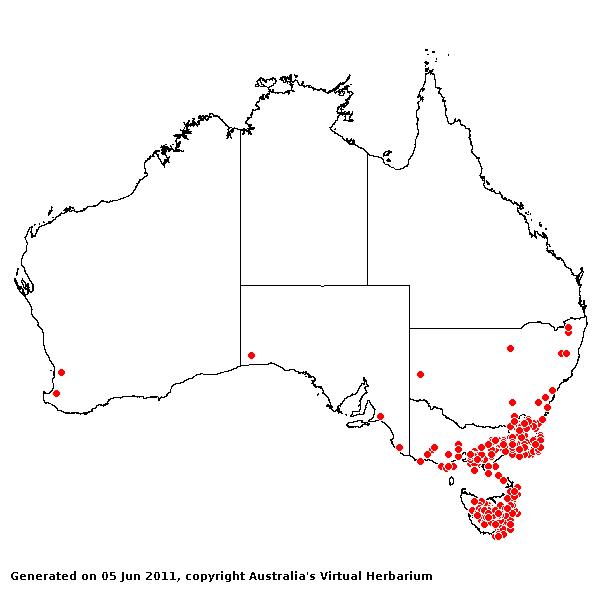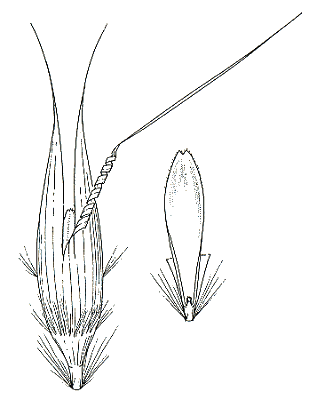Rytidosperma penicillatum (Labill.) Connor
& Edgar. New Zealand J. Bot., 17(3): 327 (1979).
Classification. (GPWG 2001) : Subfamily Danthonioideae. Tribe
Danthonieae.
Basionym and/or
Replacement Name: Arundo
penicillata Labill., Nov. Holl. Pl. 1: 26, t. 34 (1804).
Type of Basionym or
Protologue Information: HT: Labillardière s.n., Australia: Tasmania
(FI-W(photo, K)).
Recent synonyms: Danthonia penicillata (Labill.) P.Beauv., Notodanthonia penicillata
(Labill.) Zotov, Austrodanthonia penicillata (Labill.) H.P.Linder.
Key references (books and floras): [1952] C.A.Gardner, Flora of Western
Australia 1 Gramineae (57 as Danthonia penicillata), [2002] D.Sharp
& B.K.Simon, AusGrass, Grasses of Australia, [2008] S.W.L.Jacobs, R.D.B.Walley
& D.J.B.Wheeler, Grasses of New South Wales (145).
Illustrations:
[1952] C.A.Gardner, Flora of Western Australia 1 Gramineae (55,
Pl.14 as Danthonia), [2005] K.Mallet (ed.), Flora of Australia 44B:
Poaceae 3 (Fig. 11, C-D), [2008] S.W.L.Jacobs, R.D.B.Whalley &
D.J.B.Wheeler, Grasses of New South Wales, 4th edn (145).
Derivation: L. penicillus,
a small brush; -ata, possessing. With tufts of long hairs on the lemmas.
Habit.
Perennial. Culms geniculately ascending or decumbent, stature slender to
delicate, 12–75 cm tall, 3–4 -noded. Mid-culm nodes glabrous. Leaf-sheaths
smooth or scaberulous, glabrous on surface or hairy. Ligule a fringe of hairs.
Leaf-blades filiform or linear, flat or involute, 7–15 cm long, 1–2 mm wide.
Leaf-blade surface indumented.
Inflorescence.
Inflorescence solid, a panicle. Panicle linear, 5–10 cm long.
Spikelets.
Spikelets pedicelled. Fertile spikelets many flowered, with at least 2 fertile
florets (3–6), comprising 3–6 fertile floret(s), with diminished florets at the
apex, cuneate, laterally compressed, 7–16 mm long.
Glumes. Glumes
similar, thinner than fertile lemma. Lower glume lanceolate, membranous,
without keels, 9 -nerved. Upper glume lanceolate, 10–12 mm long, membranous,
without keels, 5 -nerved.
Florets.
Fertile lemma 2–3.6 mm long, without keel, 9 -nerved. Lemma surface glabrous.
Lemma apex lobed, awned, 3 -awned. Median (principal) awn from a sinus, 11–12
mm long overall, with a twisted column. Lateral lemma awns present. Lodicules
present. Anthers 3. Grain 1.8–2.5 mm long.
Continental
Distribution: Tropical Asia and Australasia.
Australian
Distribution: New South Wales, Victoria, Tasmania.
New South Wales:
South Coast, Central Tablelands, Southern Tablelands, South-Western Slopes. Victoria:
East Gippsland, Eastern Highlands, Gippsland Plain, Grampians, Midlands, Otway
Plain, Otway Range, Riverina, Snowfields, Wannon. Tasmania: North West,
West Coast, Central Highlands, Midlands, Ben Lomond, East Coast.
Notes. Similar
to R. racemosum, but glumes longer than the cluster of spikelets, and
with callus hairs overtopping lower lemma hairs, and the callus being longer
and more slender; however, there are intermediate specimens which cannot be
placed with confidence. Plants from Papua New Guinea are coarser, often
subrhizomatous, and the upper dorsal hair tufts are frequently missing. These
forms show somee similarity to alpine plants from NSW and Victoria.
New
South Wales Tablelands, and south through Victoria into Tasmania, altitude
30–1720 m, subalpine woodland, marshes, and grassland, and at lower altitudes
often in light shade. Flowers Jan.






